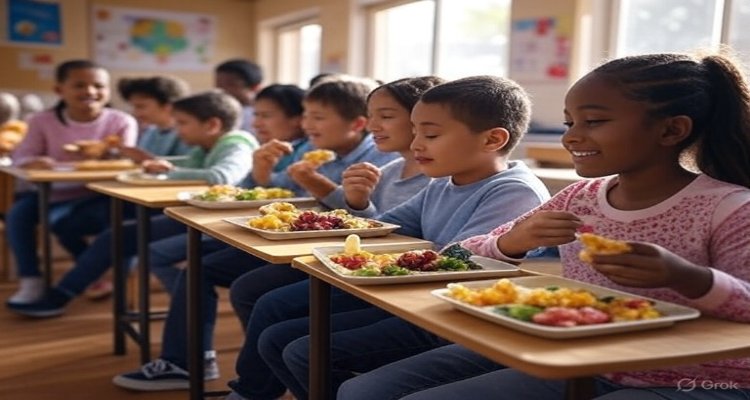Impact of School Meal Programmes
School meal programmes feed 466 million children worldwide, tackling hunger, boosting learning, and driving local economies.
Introduction: More Than Just a Meal
For millions of children around the world, a plate of food at school is not simply lunch—it is a lifeline. Beyond filling stomachs, school meal programmes are proving to be one of the most effective tools to fight hunger, improve learning, and lift entire communities out of poverty. According to the United Nations World Food Programme’s (WFP) flagship report The State of School Feeding Worldwide, the number of children receiving school meals has surged by 20% since 2020, reaching an astonishing 466 million students globally.
Context & Background: A Global Social Safety Net
The idea of feeding children at school is not new. From India’s Mid-Day Meal Scheme—now the Pradhan Mantri Poshan Shakti Nirman (PM POSHAN) programme—to large-scale initiatives in Africa and Latin America, governments have long recognized the power of school meals to fight malnutrition and keep children in classrooms.
The COVID-19 pandemic disrupted these programmes, exposing how critical they are for vulnerable families. As classrooms reopened, governments doubled down. Global funding for school meals more than doubled from $43 billion in 2020 to $84 billion in 2024, with an overwhelming 99% of funding now coming directly from national budgets, marking a historic shift from foreign aid to domestic policy.
Main Developments: Scaling Up, Reaching Further
The latest WFP report highlights several encouraging developments:
- 466 million children fed through school programmes worldwide.
- 80 million more children served since 2020, despite global crises.
- Africa leading the surge, with 20 million additional children receiving meals in countries such as Kenya, Madagascar, Ethiopia, and Rwanda.
- The School Meals Coalition, a global partnership of more than 100 governments, driving the fastest expansion in history.
Perhaps most striking is the fact that school meals are no longer treated as charity. They are now embedded in national policy frameworks as a strategic investment in health, education, and economic development.
Expert Insight: Why It Matters
“School meals are one of the smartest, most cost-effective investments a nation can make,” said WFP Executive Director Cindy McCain in the report’s foreword. “They are a pathway out of poverty and into opportunity.”
Education experts echo this sentiment, noting that hungry children cannot learn. Studies have shown that providing food at school increases attendance, reduces dropout rates, and improves performance in math and literacy. “A nutritious meal improves attention span and cognitive function in ways that teacher training or classroom technology often cannot,” said Dr. Kwame Mensah, an education policy analyst in Ghana.
Impact & Implications: Beyond the Classroom
The impact of school meal programmes ripples far beyond children’s health and education:
- Economic Multiplier: Every $1 invested generates between $7 and $35 in economic benefits, from improved learning outcomes to healthier workforces.
- Job Creation: Feeding 466 million children creates an estimated 7.4 million jobs globally, many of them for women as cooks, food suppliers, and community workers.
- Support for Farmers: Home-grown school feeding models connect schools with local farmers, strengthening food systems and rural economies.
- Gender Equality: Girls benefit disproportionately, with improved school attendance, nutrition, and long-term economic prospects.
- Resilience to Crises: As the largest social safety net in the world, school meal programmes cushion the impact of climate disasters, pandemics, and conflict.
India has even enshrined school meals as a legal right, underscoring their importance not only as a welfare programme but as a matter of social justice.
Conclusion: A Recipe for the Future
School meal programmes are among the rare success stories in global development. They address hunger, strengthen education, create jobs, and empower communities—all while providing governments with one of the highest returns on investment in public policy.
The challenge ahead lies in scaling these programmes equitably. While middle- and high-income countries are expanding rapidly, low-income nations still struggle with funding gaps despite the greatest need. Bridging this divide will determine whether school meals continue to be a global success—or an opportunity missed.
As the WFP report makes clear, a simple plate of food can change the trajectory of a child’s life—and, by extension, the future of nations.
Disclaimer : This article is for informational purposes only. It does not constitute financial, policy, or health advice.











